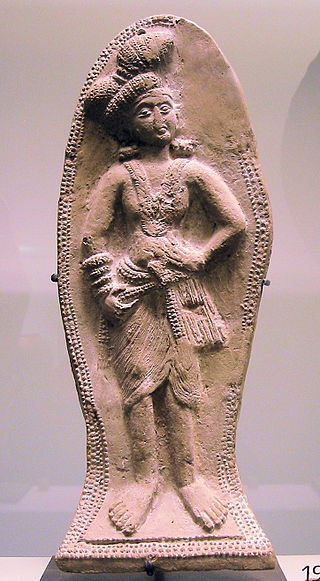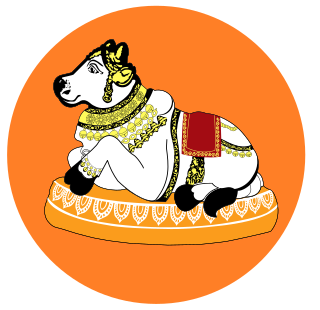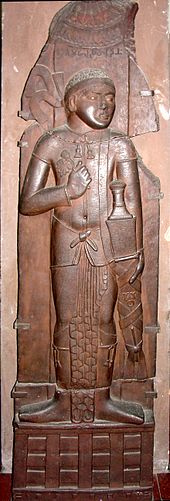
Kalki, also called Kalkin, is the prophesied tenth and final incarnation of the god Vishnu. He is described to appear in order to end the Kali Yuga, one of the four periods in the endless cycle of existence (Krita) in Vaishnava cosmology. The end of the Kali Yuga states this will usher in the new epoch of Satya Yuga in the cycle of existence, until the Mahapralaya.

Demetrius I Anicetus, also called Damaytra was a Greco-Bactrian and later Indo-Greek king, who ruled areas from Bactria to ancient northwestern India. He was the son of the Greco-Bactrian Kingdom's ruler Euthydemus I and succeeded him around 200 BC, after which he conquered extensive areas in what is now southern Afghanistan, Iran and Pakistan and India.

Menander I Soter was a Greco-Bactrian and later Indo-Greek King who administered a large territory in the Northwestern regions of the Indian Subcontinent and Central Asia. Menander is noted for having become a patron and convert to Greco-Buddhism and he is widely regarded as the greatest of the Indo-Greek kings.

Magadha also called the Kingdom of Magadha or the Magadha Empire, was a kingdom and empire, and one of the sixteen Mahajanapadas, 'Great Kingdoms' of the Second Urbanization, based in southern Bihar in the eastern Ganges Plain, in Ancient India. Magadha was ruled by the Brihadratha dynasty, the Haryanka dynasty, the Shaishunaga dynasty, the Nanda dynasty, the Mauryan dynasty, the Shunga dynasty and the Kanva dynasty. It lost much of it territories after being defeated by the Satavahanas of Deccan in 28 BC and was reduced to a small principality around Pataliputra. Under the Mauryas, Magadha became a pan-Indian empire, covering large swaths of the Indian subcontinent and Afghanistan.

The word Yona in Pali and the Prakrits, and the analogue Yavana in Sanskrit and Yavanar in Tamil, were words used in Ancient India to designate Greek speakers. "Yona" and "Yavana" are transliterations of the Greek word for "Ionians", who were probably the first Greeks to be known in India.

The Indo-Greek Kingdom, or Graeco-Indian Kingdom, also known historically as the Yavana Kingdom (Yavanarajya), was a Hellenistic-era Greek kingdom covering various parts of modern-day Afghanistan, Pakistan and northwestern India. This kingdom was in existence from c. 200 BC to c. 10 AD.

The Indo-Scythians were a group of nomadic people of Iranic Scythian origin who migrated from Central Asia southward into the northwestern Indian subcontinent: the present-day South Asian regions of Afghanistan, Pakistan and northern India. The migrations persisted from the middle of the second century BCE to the fourth century CE.
The Shunga dynasty was the seventh ruling dynasty of Magadha and controlled most of the northern Indian subcontinent from around 187 to 73 BCE. The dynasty was established by Pushyamitra, after taking the throne of Magadha from the Mauryas. The Shunga Empire's capital was Pataliputra, but later emperors such as Bhagabhadra also held court at Besnagar in eastern Malwa. This dynasty is also responsible for successfully fighting and resisting the Greeks in Shunga-Greek War.

Pushyamitra Shunga or Pushpamitra Shunga was the founder and the first ruler of the Shunga Empire which he established to succeed the Maurya Empire. His original name was Puṣpaka or Puṣpamitra and the confusion between Puṣyamitra and Puṣpamitra arose because of the erroneous readings of 'p' and 'y' in the manuscripts.

Brihadratha was the 9th and last Emperor of the Mauryan Empire. He ruled from 187 to 185 BCE, when he was overthrown and assassinated by his General, Pushyamitra Shunga, who went on to establish the Shunga Empire. The Mauryan territories, centred on the capital of Pataliputra, had grown considerably from the time of Ashoka to when Brihadratha came to the throne.

The Kanva dynasty or Kanvavamsha was the eighth ruling dynasty of Magadha, established after Vasudeva Kanva overthrew the preceding Shunga dynasty and ruled from 73 BCE to 28 BCE.

Kosala, sometimes referred to as Uttara Kosala was one of the Mahajanapadas of ancient India. It emerged as a small state during the Late Vedic period and became one of the earliest states to transition from a lineage-based society to a monarchy. By the 6th century BCE, it had consolidated into one of the four great powers of ancient northern India, along with Magadha, Vatsa, and Avanti.

Shalishuka Maurya was the 6th Emperor of the Indian Maurya dynasty. He ruled from 215–202 BCE. He was the successor and son of Samprati Maurya. While the Yuga Purana section of the Gargi Samhita mentions him as a quarrelsome, unrighteous ruler, he is also noted as being of "righteous words"

The History of the Indo-Greek Kingdom covers a period from the 2nd century BCE to the beginning of the 1st century CE in northern and northwestern Indian subcontinent. There were over 30 Indo-Greek kings, often in competition on different territories. Many of them are only known through their coins.

The Shiva Purana is one of eighteen major texts of the Purana genre of Sanskrit texts in Hinduism, and part of the Shaivism literature corpus. It primarily revolves around the Hindu god Shiva and goddess Parvati, but references and reveres all gods.
Vasumitra was the fourth Shunga Emperor, who reigned from 131 to 124 BCE. He was the son of Emperor Agnimitra by his empress-consort Dharini and the brother or half-brother of Emperor Vasujyesththa and the step son of Queen Mālavikā, the third wife of Emperor Agnimitra.

Simuka alias Sudraka was an ancient Indian king belonging to the Satavahana dynasty, which ruled the Deccan region. He is mentioned as the first king in a list of royals in a Satavahana inscription at Nanaghat. In the Puranas, the name of the first Andhra (Satavahana) king is variously spelt as Shivmukha, Sishuka, Sindhuka, Chhismaka, Shipraka, Srimukha, etc. These are believed to be corrupted spellings of "Simuka", resulting from copying and re-copying of manuscripts.

The legacy of the Indo-Greeks starts with the formal end of the Indo-Greek Kingdom from the 1st century, as the Greek communities of central Asia and northwestern India lived under the control of the Kushan branch of the Yuezhi, Indo-Scythians and Indo-Parthian Kingdom. The Kushans founded the Kushan Empire, which was to prosper for several centuries. In the south, the Greeks were under the rule of the Scythian Western Kshatrapas.

The sources used to reconstruct the history of the Indo-Greeks are few and disparate, leading to much uncertainty about the precise state of the Indo-Greek kingdom and its chronology. Sources related to the Indo-Greeks can be classified into various categories: ancient literary sources from both the West and the Indian world, archaeological sources from the general area of present day Pakistan, Kashmir and North Indian states of Punjab, Haryana, Himachal Pradesh, Uttar Pradesh & Bihar, and numismatical sources, which are abundant and well-preserved but often rather cryptic.

The Shunga–Greek War was a number of conflicts fought between the Shunga Empire and the Greco-Bactrian Kingdom. The Greek ruler Demetrius is regarded to have invaded the subcontinent after his win over the Kabul Valley. The outcome of the war remains unclear but the Shungas were able to successfully resist the invasion and expel the Greeks out of Mathura.















